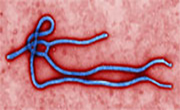
WEDNESDAY, March 25, 2015 (HealthDay News) — Ebola appears to do its damage faster in young children than it does in adults, a new study reports.
Young children infected with Ebola during the current West African epidemic developed symptoms and required hospitalization sooner than adults. They also died days earlier than did adults with the infection, according to research from the World Health Organization’s Ebola Response Team.
“Anybody who develops Ebola needs the best care promptly, but these data suggest that things move even more quickly in young children,” said report co-author Christopher Dye, the WHO’s director of strategy.
“We need to be vigilant so we can get young children into care quickly,” he added.
Findings from the study are published in the March 26 issue of the New England Journal of Medicine.
Until now, little has been known about how Ebola affects children because kids are less likely to become infected with the deadly virus, Dye said.
For example, there have been just over 3,800 reported cases of Ebola in children 14 and younger during the current epidemic, compared with more than 11,000 cases in those 15 to 44 and more than 4,500 cases in adults 45 and older, according to the WHO’s latest figures.
It’s likely that children aren’t exposed to Ebola as much as adults, because they don’t care for people stricken with the virus and they don’t participate in burial rituals, which are two of the most frequent means of Ebola transmission, Dye said.
But the West African epidemic has gone on long enough that the virus has made its way to young children and adolescents, causing death and debilitating illness.
WHO researchers found that, once infected, children succumb to Ebola at a much more rapid pace than adults:
- Children 15 and younger typically are infected for about seven to nine days before Ebola’s symptoms surface. It takes about 10 days for symptoms to surface in those 16 to 44, and 11 days for adults older than 45.
- Infants end up hospitalized sooner, with children younger than 1 year requiring intensive medical care within about three days of symptom onset, compared with about four to five days for everyone else.
- Death comes sooner for young children infected with Ebola, within about five to six days of symptom onset for children 4 and younger and about seven days for kids between 5 and 6 years old, according to the study. Adolescents and adults typically die within eight to nine days of symptom onset, the researchers found.
However, researchers also found that children aged 10 to 15 appear better able than all other age groups to survive Ebola.
Only about 50 percent of children in that age range died from an Ebola infection, while the death rate ranged as high as 90 percent for infants and 80 percent for children aged 1 to 4 years, the WHO team reported. For those between 16 and 44, the fatality rate was 65 percent, according to the report.
At this point, doctors do not know why Ebola tends to strike young children with more ferocity than adults, Dye said.
It might be due to the massive fluid loss that occurs with the illness, as those infected suffer from vomiting, diarrhea and bleeding, he said. At this point, providing fluids is the best life-saving treatment for Ebola, and children are more vulnerable to dehydration from fluid loss.
“Patients become dehydrated very quickly once they develop symptoms like diarrhea, and it’s more difficult to maintain fluid balances in young children,” Dye said. “It’s one possible reason we see the pattern that we do.”
These new figures show that parents and health care workers need to pay special attention to children during an Ebola outbreak, said Dr. Lee Norman, an Ebola expert and chief medical officer of the University of Kansas Hospital.
“It just, to me, serves as a time-honored reminder that children are not just miniature adults,” Norman said. “If kids become ill faster in the course of it, and have a shortened time from symptom onset to hospitalization and death, everything needs to be recognized more quickly and acted upon more quickly.”
Norman agreed that fluid loss probably is the reason why Ebola is so much more devastating to children. “By the time they’re behind on fluids, they’re really behind,” he said. “Catch-up is harder, and everything is accelerated in terms of the severity of their illness.”
However, keeping an eye on kids in an Ebola-ridden region is not simple.
The WHO team noted that fever tended to be the first symptom shown by children with Ebola, and that they were more likely to have a fever than adults.
Unfortunately, fever is not a very useful symptom. “There are lots of reasons to have a fever in the remote parts of Africa we’re talking about,” Norman said. “It’s hard to jump on it quickly enough when you’re in a remote area, as the logistical considerations are pretty daunting, and if there’s a false alarm then you’ll be less likely to jump the next time.”
The study also found that children are less likely than adults to report other symptoms that might indicate an Ebola infection, such as stomach or chest pain, muscle and joint pain, trouble breathing or swallowing and hiccups.
More information
For more on the Ebola virus, visit the U.S. Centers for Disease Control and Prevention.
Copyright © 2025 HealthDay. All rights reserved.

